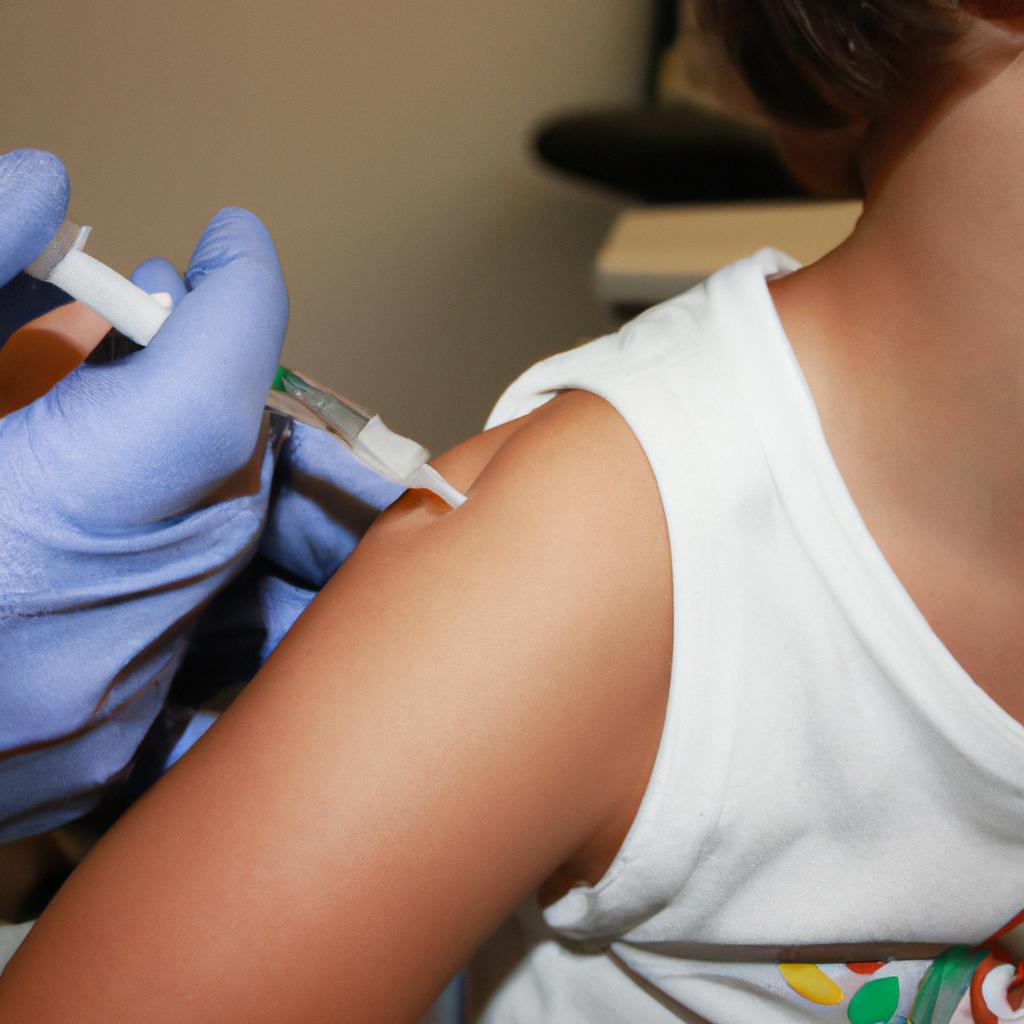Improving healthcare quality is a paramount concern for society and individuals alike. The provision of high-quality healthcare services ensures that patients receive the best possible care, leading to improved outcomes and increased patient satisfaction. As such, it becomes imperative to explore strategies and guidelines aimed at enhancing healthcare quality across various settings.
Consider the case of Mrs. Smith, a 65-year-old woman with multiple chronic conditions who recently sought medical attention for uncontrolled hypertension. Despite her regular visits to different healthcare providers, she struggles with persistent high blood pressure readings and experiences complications that negatively impact her overall well-being. This scenario highlights the importance of addressing healthcare quality issues comprehensively in order to optimize patient outcomes while also reducing costs associated with preventable adverse events or suboptimal care delivery.
In this article, we delve into the multifaceted nature of improving healthcare quality by examining key principles and approaches that can be adopted on both the societal and individual levels. By exploring evidence-based practices, promoting effective communication among stakeholders, implementing robust quality improvement initiatives, and fostering patient-centered care models, we aim to provide readers with a comprehensive guide towards achieving higher standards of healthcare quality for the benefit of society as a whole.
Understanding Quality in Healthcare
One example that illustrates the importance of quality in healthcare is the case of Mr. Johnson, a 55-year-old man who presented with chest pain and was admitted to a local hospital. Despite receiving prompt medical attention, his condition worsened due to delays in diagnosing and treating his heart attack. This delay resulted in irreversible damage to his heart muscle and led to long-term complications that could have been prevented with timely intervention. This case highlights the critical role that quality plays in patient outcomes and emphasizes the need for a comprehensive understanding of healthcare quality.
To comprehend quality in healthcare, it is essential to recognize its multifaceted nature. Quality encompasses various dimensions, including effectiveness, safety, timeliness, efficiency, equity, and patient-centeredness. Effectiveness refers to the extent to which healthcare interventions achieve desired outcomes based on current evidence-based practices. Safety focuses on preventing harm to patients from errors or adverse events during their care journey. Timeliness pertains to minimizing wait times and delays in accessing services while ensuring timely diagnosis and treatment.
Moreover, efficiency involves optimizing resource utilization without compromising patient care standards. Equity necessitates fair distribution of healthcare resources and eliminating disparities among different population groups. Lastly, patient-centeredness underscores involving patients as active participants in decision-making processes and tailoring care plans according to their preferences and values.
In considering these dimensions of quality, individuals can better understand how healthcare systems function and identify areas for improvement. By recognizing the significance of each dimension—effectiveness, safety, timeliness, efficiency, equity, and patient-centeredness—they can actively participate in enhancing overall healthcare quality.
By understanding this comprehensive view of healthcare quality, individuals become equipped with knowledge necessary for identifying key measures that ensure high-quality care for all patients regardless of their backgrounds or circumstances. In the subsequent section about “Identifying Key Measures of Healthcare Quality,” we will delve deeper into specific indicators used by experts to assess healthcare performance at both the individual and system levels.
Identifying Key Measures of Healthcare Quality
Transitioning from our understanding of quality in healthcare, let us now explore the essential key measures that help evaluate and improve healthcare quality. To illustrate this further, consider the following scenario:
Imagine a patient named Sarah who visits her local hospital with complaints of severe abdominal pain. The doctors diagnose her with appendicitis and promptly schedule her for surgery. However, during the operation, an instrument is accidentally left inside Sarah’s abdomen. This unfortunate incident highlights the importance of identifying key measures to ensure high-quality care.
To effectively measure healthcare quality, several indicators can be utilized:
- Patient Satisfaction: gauging patients’ experiences and perceptions of their overall care through surveys or feedback forms.
- Clinical Outcomes: assessing specific health outcomes such as mortality rates, infection rates, readmission rates, or improvement in symptoms.
- Adherence to Best Practices: evaluating whether healthcare providers follow evidence-based guidelines and protocols for treatments and procedures.
- Accessible Care: examining factors like waiting times for appointments or emergency room visits, geographical proximity to healthcare facilities, and availability of specialized services.
In order to better understand these measures in practice, consider the table below which presents a comparison between two hospitals based on various quality indicators:
| Quality Indicator | Hospital A | Hospital B |
|---|---|---|
| Mortality Rate | 4% | 2% |
| Patient Satisfaction | 75% | 90% |
| Adherence to Guidelines | 80% | 95% |
| Average Waiting Time | 1 hour | 30 minutes |
As we can see from the table above, Hospital B demonstrates better performance across all measured aspects compared to Hospital A. These results highlight how crucial it is for healthcare providers to identify areas requiring improvement so they can enhance their service delivery accordingly.
By focusing on these vital measures of healthcare quality – patient satisfaction, clinical outcomes, adherence to best practices, and accessible care – healthcare organizations can ensure that they are delivering the highest standard of care possible. In doing so, they not only improve patient experiences but also enhance overall health outcomes within their communities.
Transitioning seamlessly into our next section on promoting patient safety, let us now delve further into strategies aimed at safeguarding patients from preventable harm and errors in healthcare settings.
Promoting Patient Safety
Building upon the identification of key measures of healthcare quality, this section delves into the crucial aspect of promoting patient safety. By implementing strategies and protocols to minimize errors and adverse events, healthcare providers can create a safer environment for patients.
To illustrate the importance of patient safety, let us consider a hypothetical case study. Imagine a 65-year-old individual undergoing surgery for a routine knee replacement procedure. During the operation, an error occurs, leading to an infection in the surgical site. This unfortunate incident could have been prevented through effective patient safety practices such as proper sterilization techniques and adherence to surgical checklists.
To ensure optimal patient safety outcomes, healthcare systems must prioritize several key areas:
-
Effective Communication: Clear and concise communication among healthcare professionals is vital for preventing medical errors. Standardizing handoff processes during shift changes and utilizing technologies that facilitate seamless information exchange are examples of effective communication strategies.
-
Medication Safety: Ensuring accurate prescribing, dispensing, administration, and monitoring of medications helps prevent medication errors and adverse drug reactions. Implementation of computerized physician order entry (CPOE) systems with built-in clinical decision support can significantly enhance medication safety.
-
Infection Control: Robust infection control practices play a critical role in minimizing hospital-acquired infections. Strict adherence to hand hygiene protocols, proper disinfection procedures, and appropriate use of personal protective equipment by healthcare staff are essential elements in preventing infections.
-
Error Reporting Systems: Establishing confidential reporting systems encourages healthcare workers to share incidents without fear of retribution or blame. These systems allow organizations to identify trends and implement corrective actions promptly.
Table: Impact of Promoting Patient Safety on Healthcare Quality
| Improved Patient Outcomes | Enhanced Trust in Healthcare System | Reduced Healthcare Costs |
|---|---|---|
| Decreased mortality rates | Increased patient satisfaction | Fewer malpractice claims |
| Minimized adverse events | Improved healthcare provider morale | Lower hospital readmission rates |
| Reduced length of hospital stays | Reinforced public confidence | Decreased resource utilization |
By prioritizing patient safety through effective communication, medication safety, infection control, and error reporting systems, healthcare providers can improve patient outcomes, enhance trust in the healthcare system, and reduce overall costs.
As we acknowledge the significance of promoting patient safety, the subsequent section will explore strategies for enhancing access to quality healthcare. This ensures that individuals receive timely and appropriate care when they need it most.
Enhancing Access to Quality Healthcare
Building upon the importance of promoting patient safety, another critical aspect in improving healthcare quality is enhancing access. Ensuring that individuals have timely and affordable access to high-quality care is essential for a society’s overall well-being. For instance, let us consider the case of Sarah, a middle-aged woman with a chronic illness living in a remote rural area.
Paragraph 1:
Sarah resides in an isolated region where medical facilities are scarce and often inaccessible due to geographical barriers. Consequently, she faces numerous challenges in accessing quality healthcare services. This lack of accessibility not only hinders her ability to manage her condition effectively but also exacerbates her health outcomes over time. It becomes evident that addressing this issue is crucial for bridging such disparities and achieving equitable healthcare for all.
- Limited availability of primary care providers.
- Insufficient transportation options for patients residing in remote areas.
- High costs associated with specialized treatments and medications.
- Inadequate insurance coverage leading to financial burdens on individuals seeking necessary care.
Paragraph 2:
To overcome these barriers and enhance access to quality healthcare, several strategies can be implemented:
| Strategies | Description |
|---|---|
| Telemedicine | Utilizing technology to provide virtual consultations and remote monitoring for patients unable to visit physical clinics or hospitals. |
| Mobile Clinics | Deploying mobile units equipped with basic diagnostic tools and medical professionals to reach underserved communities directly. |
| Community Health Workers | Empowering trained community members who can offer basic preventive care, education, and assistance in navigating the healthcare system within their own neighborhoods. |
| Financial Support Programs | Establishing initiatives that provide subsidies or grants for low-income individuals, enabling them to afford necessary treatments and medications more easily. |
Paragraph 3:
By implementing these measures, we can begin closing the gap between those who currently struggle to access quality healthcare and those who have easier accessibility. Enhancing access not only improves the health outcomes of individuals like Sarah but also contributes to a healthier society as a whole. As we move forward, it becomes evident that empowering patients and caregivers is another crucial step in our journey towards achieving comprehensive healthcare for everyone.
With a focus on enhancing access established, the subsequent section will delve into the importance of empowering patients and caregivers within the healthcare system.
Empowering Patients and Caregivers
In order to improve healthcare quality, it is crucial to focus on enhancing access for all individuals. One example that highlights the importance of this aspect is the case of Maria, a single mother living in a rural area with limited access to healthcare facilities. Due to the lack of nearby clinics and transportation issues, Maria struggled to receive timely medical care for her chronic condition, resulting in worsened health outcomes.
To address such challenges and ensure equitable access to quality healthcare, several key strategies can be implemented:
-
Expanding Telehealth Services: By leveraging technology, telehealth services provide an opportunity for patients like Maria to connect with healthcare professionals remotely. This allows them to receive medical advice, consultations, and even prescriptions without needing physical visits. The convenience and accessibility offered by telemedicine can significantly improve patient experiences and increase their adherence to treatment plans.
-
Developing Community Health Programs: Establishing community-based initiatives focused on preventive care can help bridge the gap between underserved populations and quality healthcare. These programs could include health screenings, educational workshops, and outreach efforts targeted at vulnerable communities. By bringing healthcare services closer to those in need, we can empower individuals like Maria with knowledge about their health and enable early intervention.
-
Improving Transportation Accessibility: Lack of reliable transportation often acts as a barrier preventing individuals from accessing necessary medical care. Collaborating with transportation companies or local authorities to develop cost-effective solutions like shuttle services or ride-sharing options specifically tailored for healthcare purposes can greatly enhance accessibility for marginalized communities.
-
Addressing Socioeconomic Disparities: Income disparities have a significant impact on people’s ability to afford quality healthcare services. Implementing policies aimed at reducing socioeconomic barriers through subsidized insurance programs or income-based fee structures will contribute towards making healthcare more accessible for everyone.
These strategies collectively strive towards creating an inclusive healthcare system where every individual has equal opportunities for receiving high-quality care regardless of their geographic location or socioeconomic status.
In addition to enhancing access, empowering patients and caregivers plays a pivotal role in improving healthcare quality. It is crucial for individuals to be active participants in their own care journey, as well as advocates for their loved ones. This empowerment can be achieved through various means:
-
Education: Providing comprehensive information about medical conditions, treatment options, and self-care techniques enables patients and caregivers to make informed decisions regarding their health. Educational resources should be easily accessible, written in plain language, and available in multiple languages to cater to diverse populations.
-
Shared Decision-Making: Encouraging open communication between healthcare providers and patients/caregivers fosters a collaborative approach towards decision-making. By involving patients and caregivers in the process, they feel empowered to actively participate and voice their concerns or preferences.
-
Support Networks: Establishing support networks such as patient advocacy groups or online communities helps individuals connect with others facing similar health challenges. These networks provide emotional support, share experiences, offer guidance on navigating healthcare systems, and empower patients and caregivers with knowledge from peer perspectives.
By implementing these strategies, we can transform the traditional patient-provider dynamic into a partnership that values the insights and contributions of all stakeholders involved. Empowered patients become proactive participants in managing their health outcomes while ensuring that caregiving roles are recognized and supported within the healthcare system.
As society progresses towards a more patient-centered approach to healthcare delivery by enhancing access and empowering individuals, it becomes evident that collaboration among different stakeholders is essential for continuous improvement.
Collaborating for Continuous Improvement
By empowering patients and caregivers, we foster a culture of active participation in healthcare decision-making. Now let us explore the importance of collaboration among various stakeholders to achieve continuous improvement in healthcare quality.
To illustrate the significance of collaboration, consider the case study of an urban community hospital struggling with high readmission rates among heart failure patients. Recognizing that addressing this issue requires collective effort, the hospital forms a multidisciplinary team comprising cardiologists, nurses, social workers, and patient advocates. By leveraging their diverse expertise and perspectives, they develop targeted interventions aimed at improving care coordination, medication adherence, and patient education. This collaborative approach not only reduces readmissions by 20% within six months but also enhances overall patient satisfaction.
Collaboration is essential for driving continuous improvement in healthcare quality. It allows for cross-pollination of ideas, knowledge sharing, and better utilization of resources. To effectively collaborate towards achieving higher standards of care delivery, stakeholders must:
- Foster open communication channels that encourage meaningful dialogue.
- Embrace a non-hierarchical structure where everyone’s contributions are valued.
- Establish shared goals and metrics that uphold transparency and accountability.
- Encourage ongoing learning through interprofessional training programs.
| Stakeholders | Roles | Contribution |
|---|---|---|
| Healthcare | Providers (Physicians, Nurses) | Expertise in clinical practice |
| professionals | ||
| Administrators | Strategic planning | |
| Patients | Active involvement in treatment decisions | Shared responsibility |
| Researchers | Conducting studies and generating evidence | Advancing medical knowledge |
| Policymakers | Implementing regulations and policies | Aligning standards |
Collaboration among these stakeholders lays the foundation for a healthcare system that continuously improves its quality. It encourages innovation, reduces errors, enhances patient outcomes, and increases overall satisfaction.
As we progress towards a future where continuous improvement becomes the norm in healthcare settings, it is crucial to understand that collaboration is not an isolated event but rather an ongoing process. By harnessing collective intelligence and working together across disciplines, we can create a sustainable ecosystem of care that benefits individuals and society at large.
(Note: The markdown format may not be fully supported here; please convert it accordingly)
 Lost Nomad
Lost Nomad



